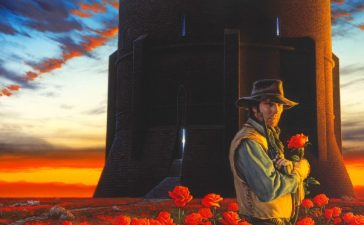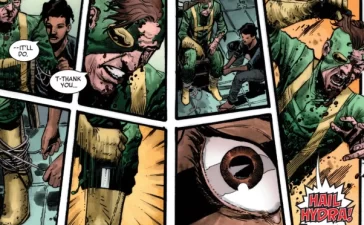
Drax the Destroyer and Marvel’s Third Cosmic Era
 As with much of the Marvel Universe, the seeds of its cosmic sphere can be traced back to the collaborations of Stan Lee and Jack Kirby, specifically the pages of Fantastic Four. While not the earliest of the First Family’s encounters with extra-terrestrials (that honor goes to #2’s tale of Skrulls), the most iconic is The Coming of Galactus. This three party story (#48-50, 1966) not only introduced many important characters (Galactus, Silver Surfer, The Watcher) it also laid a groundwork for the tone of Marvel sci-fi. Its narrative focused not simply on action, but, character, anchoring heroism in a sense of humanity. In the next decade Jim Starlin would build on these elements when crafting his philosophical, surreal journeys through the cosmic realm. This initial phase of Marvel’s cosmic story ended with Starlin’s original graphic novel The Death of Captain Marvel (1982). In the 90s though, Starlin returned to Marvel’s cosmic characters, scripting Infinity Gauntlet which ushered in a higher level of visibility for this corner of the Marvel Universe. Starlin worked on multiple projects during this period, many revolving around a pair of characters who had come to be synonymous with his Marvel work: Adam Warlock and Thanos. The final comic Starlin wrote during this second phase of his Marvel career was a Thanos series. Starlin produced the first six issues before departing, replaced by writer Keith Giffen. After wrapping up the Thanos series, Giffen would proceed to inaugurate the third era of cosmic Marvel with a Drax the Destroyer limited series.
As with much of the Marvel Universe, the seeds of its cosmic sphere can be traced back to the collaborations of Stan Lee and Jack Kirby, specifically the pages of Fantastic Four. While not the earliest of the First Family’s encounters with extra-terrestrials (that honor goes to #2’s tale of Skrulls), the most iconic is The Coming of Galactus. This three party story (#48-50, 1966) not only introduced many important characters (Galactus, Silver Surfer, The Watcher) it also laid a groundwork for the tone of Marvel sci-fi. Its narrative focused not simply on action, but, character, anchoring heroism in a sense of humanity. In the next decade Jim Starlin would build on these elements when crafting his philosophical, surreal journeys through the cosmic realm. This initial phase of Marvel’s cosmic story ended with Starlin’s original graphic novel The Death of Captain Marvel (1982). In the 90s though, Starlin returned to Marvel’s cosmic characters, scripting Infinity Gauntlet which ushered in a higher level of visibility for this corner of the Marvel Universe. Starlin worked on multiple projects during this period, many revolving around a pair of characters who had come to be synonymous with his Marvel work: Adam Warlock and Thanos. The final comic Starlin wrote during this second phase of his Marvel career was a Thanos series. Starlin produced the first six issues before departing, replaced by writer Keith Giffen. After wrapping up the Thanos series, Giffen would proceed to inaugurate the third era of cosmic Marvel with a Drax the Destroyer limited series.
At first glance, the choice of Drax for such a prominent role might seem counterintuitive. When Starlin revived the cosmic sphere, he did so by writing Silver Surfer, one of the most recognizable sci-fi characters in the medium. This is not to say Drax lacked pedigree. Co-created by Starlin and scripter Mike Friedrich for Iron Man #55, Drax dominates the issue from the first page until the last. Over time however, he would lose prominence to another key player to debut in that seminal story: Thanos. From the beginning, Starlin bound these two characters together as Drax’s whole purpose in existence was to destroy the Mad Titan. Yet in practice, Drax tended to take a backseat to Starlin’s preferred protagonists Captain Marvel and Adam Warlock. This dynamic was not helped by Starlin’s decision to give Drax the personality and intelligence of a young child when he resurrected him in the 90s. (Drax, like many of Starlin’s signature characters, did not make it out of the 70s alive). The choice was meant to be reflective of brain trauma Drax had previously suffered, but, in execution, it turned him into a poorly written Hulk clone. Later writers would restore his adult reasoning, only by then the character had drifted to the fringes of the Marvel Universe.

Giffen’s Drax (2005) opens on a transport ship ferrying criminals to the galactic prison Kyln (also the setting for Giffen’s Thanos arc). The ship experiences a malfunction, crashing on Earth, rural Alaska to be precise. Drax and four fellow inmates are the only survivors. How or why Drax came to be considered a criminal is never addressed in the narrative. At first, he appears to have regressed to his 90s personality, speaking in short, broken phrases. He is openly mocked by his fellow prisoners for being slow-witted. Initially they try working with him, but soon blows are traded and, after a particularly brutal fight, the Destroyer is left for dead.
As he has in other projects, Giffen draws on his long career in and deep knowledge of comics. The other surviving prisoners are all minor figures, including the Blood Brothers who’s only claim to fame is also debuting in Iron Man #55. (In fact, they are the main antagonists of the story. Thanos simply puts in some face time for a round of boastful cackling; the Blood Brothers do all the actual heavy lifting). Giffen drops a few humorous asides into the action, such as when an Earth teenager asks the aliens “what’s with all the cattle mutilations.” At the same time, Giffen sidesteps readers’ expectations for how such stories tend to unfold. Paibok, the Power Skrull, declares early on that the last thing any of them want to do is draw attention to themselves or bring the Avengers or Fantastic Four down on their heads. Thus, instead of hatching some plan of conquest, he schemes how to get off the planet and back to his normal life. Now this does not mean that he uses compassion to achieve his goal (hard to do that when one of your comrades is named Lunatik). Paibok has no qualms about enslaving a whole town for ship repairs and brutally slaughtering those who resist. This creates an interesting dynamic between the aliens and town which allows for some beats not as common in this type of tale.

In the midst of all this, Drax is evolving into a new form. It is at this moment that Drax gains the swirling red markings which fans associate with the character today. It has its costs, reducing his stature, while eliminating his ability to fly and shoot energy rays from his palms. Overall, his power levels have been decreased. One way Drax makes up for these losses is the adoption of a new weapon of choice: a pair of sharp blades. More importantly, Drax has shed the any hint of the rage-fueled, simple-mindedness that he possessed in the first section of the series.
The most intriguing addition that Giffen makes to the character is in the form an adolescent girl, Cammi, who takes to shadowing Drax. Cammi comes from a difficult home life; her father is absent and mother spends most of the time drunk. Such circumstances have hardened Cammi as well as provided her with a deep reserve of courage. She betrays no fear when she first comes across the marooned space criminals in the woods. Instead she delights in watching them bicker and, once Drax comes charging through, trade blows. At first Drax mistakes Cammi for the daughter Thanos murdered many years ago. Even after he regains his senses, Giffen teases that his lost child remains a motivating factor in their relationship. Cammi is a spunky teenager with an appealing personality, very much a 21st Century Rick Jones. Watching her and Drax play-off each other is one of the highlights of the series.
Art is supplied by Mitch Breitweiser who does an excellent job balancing the tones of the narrative. The villainous aliens have a suitably monstrous, yet grounded appearance. Their menace is often implied rather than displayed. There is a striking sequence when an elderly lady proves to be the only person with the courage to speak back to Paibok. Her killing is depicted in shadow while the following panel focuses on her glasses crashing to the ground. The story contains many grisly incidents, yet, their vividness is obscured on the page in the favor of atmosphere. Brian Reber’s coloring favors faded hues, so that even during the daytime the mood remains somber. This approach serves well for the establishing everyday scenes, such as Cammi’s sitting in her room talking on the phone and watching television. Occasionally, Breitweiser knits together these two threads, contrasting the otherworldliness of the aliens with the everyday aspects of small town life. One great visual detail is the rumpled suit Paibok takes to wearing during one stretch of the story. In such a way, Brietweiser channels Giffen’s famous comic sensibilities.

Giffen’s sense of defying expectations continues to the climax which involves not the pounding of fists but a logical compromise. Plot threads are wrapped up, S.H.I.E.L.D. arrives to mop up and the dead are mourned. Cammi’s friend Dex speaks an affecting tribute and the comic ends—with a cliffhanger in space?
Drax the Destroyer was never meant to be an isolated mini-series; instead it was a prologue for a cosmic event, Annihilation. Annihilation, also penned by Giffen, would prove to be a major catalyst for the Marvel Universe. Overshadowed at the time by Marvel’s Civil War, Annihilation has only grown in prominence in ensuring years. In Annihilation and its sequel Annihilation: Conquest, Giffen and a team of writers, most prominently Dan Abnert and Andy Lanning, revitalized the cosmic characters, honoring their legacies while for the first time stepping free of the shadow cast by Starlin’s iconic runs. They brought fresh tones and styles to Marvel’s space operas. While returning to some classic figures such as Drax and Adam Warlock, they also drew heavily on lesser known characters such as Star-Lord and Rocket Raccoon. Such choices gave them greater flexibility to bestow their cosmic narratives with their own voice. This third era of cosmic Marvel lasted five years from Drax the Destroyer to the Thanos Imperative. A short period perhaps, but while it lasted, it produced some of the best comics of the decade. Its own legacy is a rich one, which, even more than Starlin’s runs, is now the default framework for Marvel’s cosmic line.
Drax would play a prominent role in Annihilation, return for Conquest and become a founding member of the new Guardians of the Galaxy team which spun out of Conquest. The post-Conquest Guardians title would in turn, serve as the basis for Marvel Studios’ hit film, Guardians of the Galaxy, which gave Drax a whole new level of popularity. A pivotal step in that journey to becoming a cinematic household name was Giffen and Breitweiser’s Drax the Destroyer.








